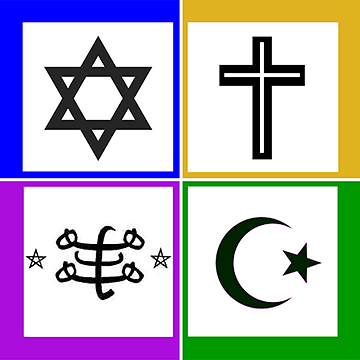My view on wearing obvious religious identifiers in public
COFFEE WITH WARREN, with Warren Harbeck
Cochrane Eagle, October 3, 2013

Symbols often associated with the four Abrahamic religions, clockwise from upper left in historical order: the Star of David (Judaism), the cross (Christianity), the crescent moon and star (Islam), and the Ringstone (Baha’i).
Graphic by Warren Harbeck
Quebec’s proposed legislation banning public servants from wearing overt religious symbols while on duty has me rethinking my own understanding of personal religious identifiers.
My comments here are not intended as a debate over the ban itself, however. Rather, what I want to focus on is the importance to me, as a Christian, of one particular, very public, identifier of a follower of Jesus, against which there can never be any law.
First, though, allow me to review some of the most recognizable symbols within the four Abrahamic religious traditions (Judaism, Christianity, Islam and the Baha’i Faith), about which I’m supposed to have a bit of knowledge.
The six-pointed Star of David is unmistakably associated with Judaism. Alluding to Israel’s greatest king from 3,000 years ago, it appears over synagogues, on sacred attire and in jewelry, as well as elsewhere. Tragically, it also became the identifying mark imposed during the Holocaust to set Jews apart for shame and elimination.
Equally unmistakable as a Christian symbol, the cross/crucifix relates to the death and resurrection of Jesus Christ. Although it is sometimes worn as just another piece of secular jewelry, for believers the wearing of the cross explicitly identifies them as followers of Jesus. Tragically, it too has been abused for evil purposes, such as the racially motivated burning of crosses on targeted people’s lawns.
The single most widely recognizable symbol of Islam is the crescent moon and star. This fairly recent symbol has its origins in the geo-political world of the Middle East and appears on the flags of some Islamic states, such as Pakistan. Abstract religious symbols were not part of the earliest days of Islam, however, because only Allah (Arabic word for “God”) was to be revered, and that word often appears in elegant calligraphy as another highly recognizable symbol of Islam.
Then there’s the Baha’i Faith’s Ringstone featured on rings and other pieces of jewelry of its followers. It consists of four lines symbolizing mortal humanity’s access to the immortal God through a series of Manifestations (divine messengers) that include Adam, Abraham, Moses, Zoroaster, Jesus, Buddha, Muhammad and, most recently, their mid-19th century founder, Bahá'u'lláh.
Now, as I was saying, the whole debate over religious symbols in public space has me seriously rethinking my own position. In fact, it forced me to turn to the Christian Scriptures to see whether they speak of any single obvious identifier as having higher priority for Christians than other expressions – something that would announce to the whole world that a person is unequivocally a follower of Jesus.
I found my answer in a letter from the Apostle Paul. And that answer had nothing to do with personal apparel or accessories.
It’s all about “love,” he writes in his Letter to the Galatians (5:22–23), and this kind of love is characterized by “joy, peace, patience, kindness, generosity, faithfulness, gentleness, and self-control.”
In my view, then, love is the authentic, meaningful mark of the Christian life, and as Paul concludes, “There is no law against such things.”
© 2013 Warren Harbeck
JoinMe@coffeewithwarren.com